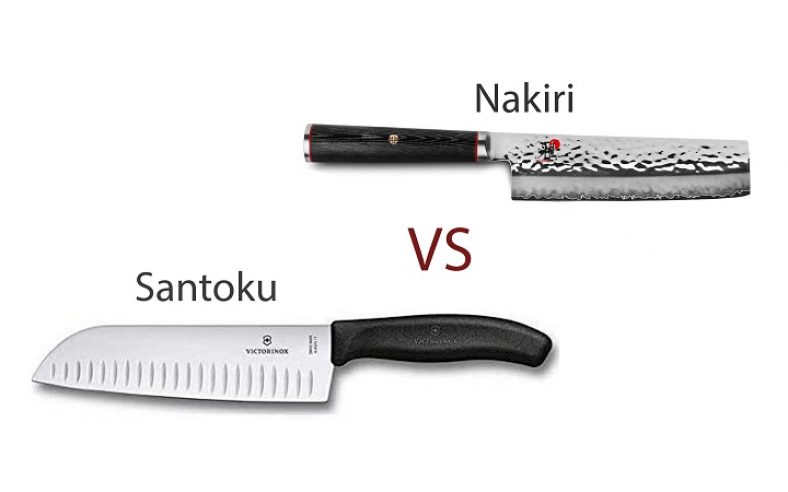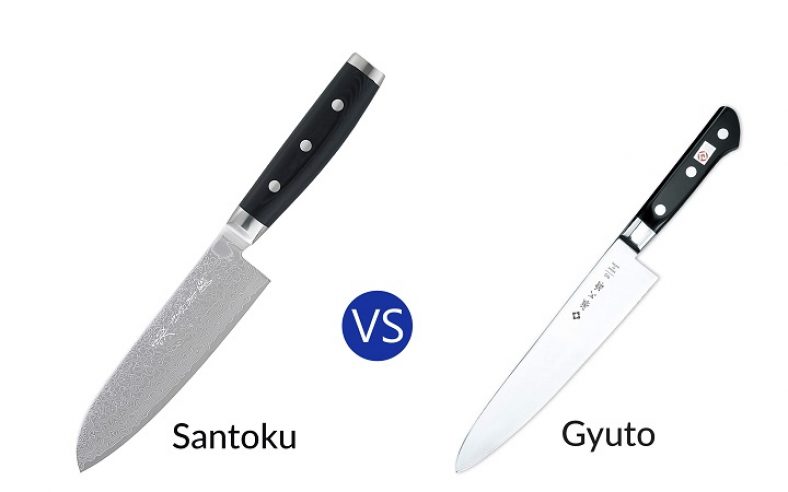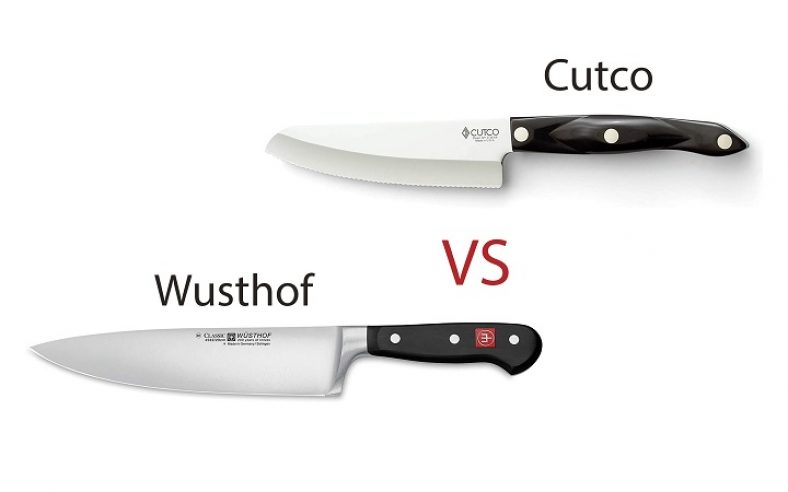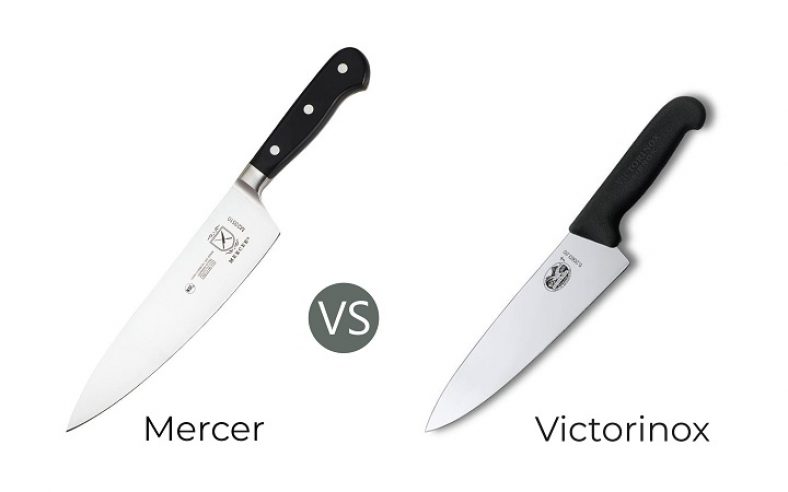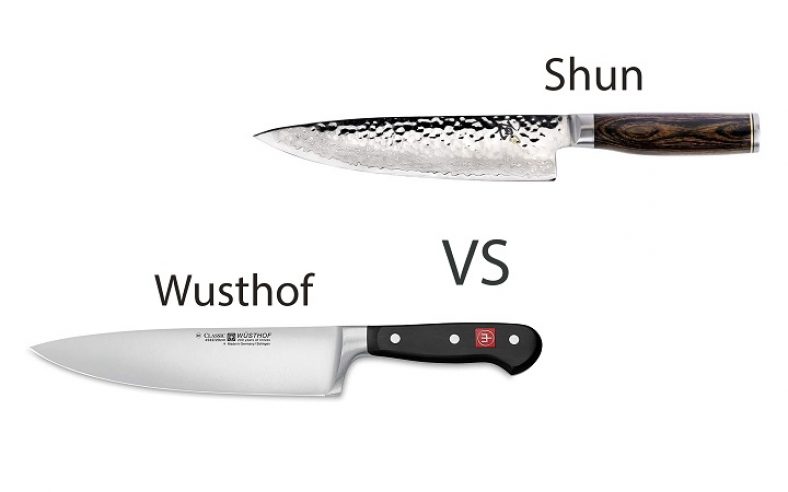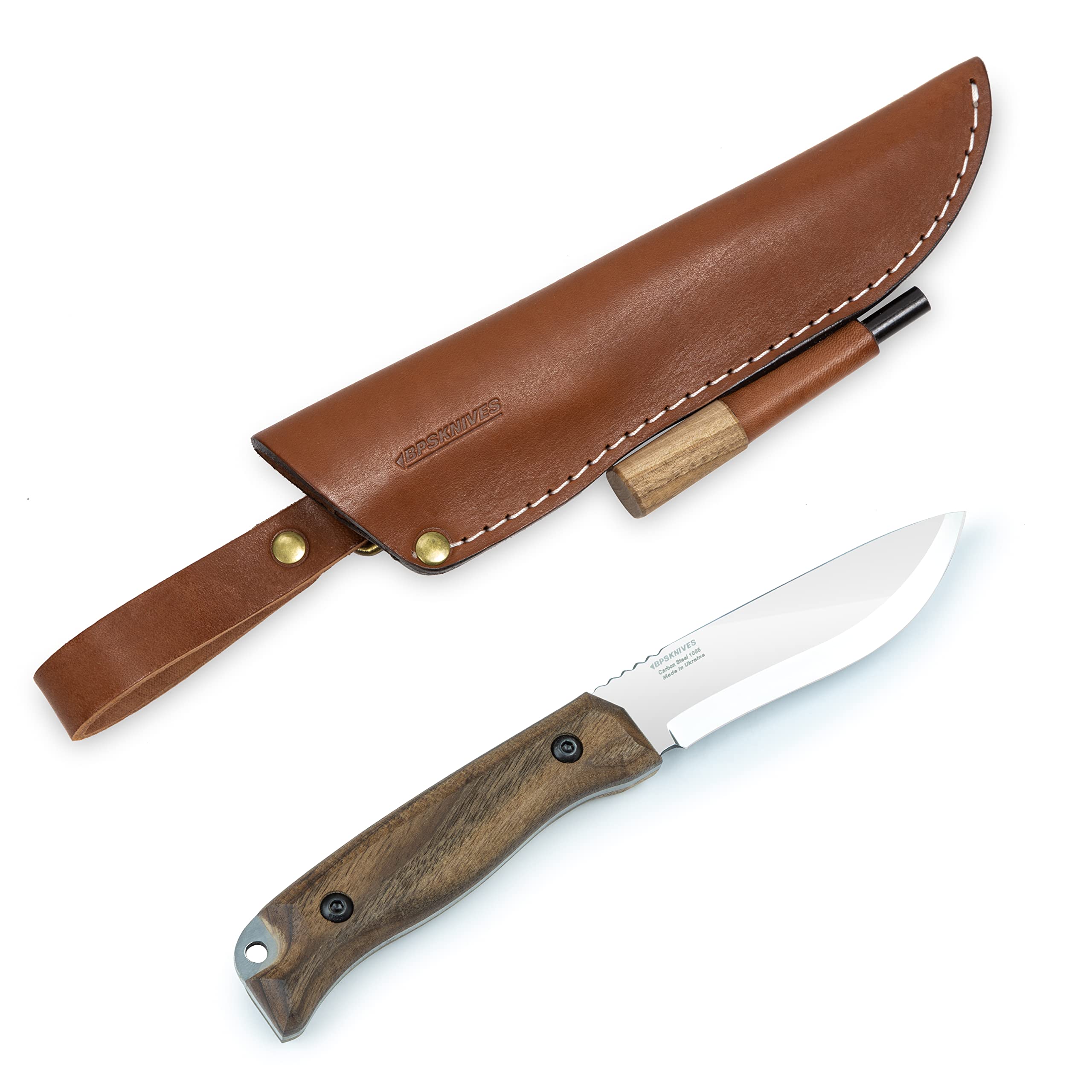All types of knives are out there, and you can get your preferred one to improve your collection. But, you’ll not find the best one until you go through the comparison of Nakiri vs Santoku. That’s because your knife set will not complete without having a piece of Japanese knife-like Nakiri and Santoku.
However, choosing your optimal one can be a bit hectic despite having a broad array of Japanese knives. Moreover, it becomes much challenging when it comes to choosing from the two beautiful knives, such as Nakiri and Santoku.
These two knives are the world’s famous and widely used all around the world. Knowing their distinctions will make it simple to make an educated selection if you need only one of them. Well, let’s know which one is the most preferable for your needs.
Overview Of The Nakiri
The word ‘Nakiri’ indicates a knife for cutting vegetables or greens when you translate it from Japanese. Also, you should know clearly why this sharp knife has built along with its translation. Indeed, this knife comes with the feature of the design with a straight-edge blade that will also get some rectangular lips.
Because of this type of blade design, the knife makes it likely to cut through the vegetables right away while using a straight push and pull motion. Moreover, you can get some highly even and thinner slices with the straight blade on this knife.
And you can slice in a more watery chopping stroke without rocking the blade just because of its straight edge. Besides, users also value the truth that its blade helps them to cut the most precise vegetables without squeezing them. Moreover, it has a lightweight blade that is far easy to get razor-sharpness.
You might not get these knives in most Japanese kitchens, unlike their rivals like Santoku and Usubu knives. But, in this debate, it doesn’t mean the Nakiri knives have no use for domestic cooks. However, it has a shortcoming that the knife has not built to be very flexible.
That’s why it’ll not cut some other things than vegetables like meat fabulously. This is because the knife is not very useful in the kitchen if you need to deal with any other stuff except vegetables. You’ll find it great to use in your kitchen if you consider the Nakiri knives’ prices.
If you’re a novice to Japanese-style cooking to make you crash in worship with the new way of cooking, then it’s for you. For more information on this issue, you can check out our review of the best Nakiri knife.
Overview Of The Santoku
As Santoku is a flexible Japanese knife, it might be very imaginative in your kitchen. The word “Santoku” is a Japanese term that stands for a single knife with three virtues. That means you can typically use this knife for three purposes, including cutting vegetables, fish, and meat.
Since the knife comes with the design of a shorter length, it’s much more straightforward and comfortable to use and handle. Also, it features a blade, which has grounded symmetrically. And the blade has made with an angle of 10-degree to 15-degree per side.
Moreover, some users care that the knife feels balanced enough because of a solid Damascus steel. This feature also makes it comparatively more durable. The shape of its blade is likely to the regular chef’s knife. That means you’ll be able to use it for professional use with Kataba edge while the Ryba edge standard for other types of knives.
Unfortunately, this knife is also not out of the issue. And the most severe problem, according to its users, is that the handle of the knife is a bit smaller. So, it’s not suitable for people with smaller or average hands. This is crucial for most Japanese items like sukiyaki beef pickled as well as daikon.
As a result, it’s hugely sharper that can make skinny slices while having a razor-sharp angle and one bevel made santoku knife. Moreover, in comparison to the double bevels, single bevels take very little to sharpen.
The knife leaves the whole blade obtainable for slicing because of not having a bolster. Furthermore, this makes the knife trouble-free to sharpen when it needs it. You’ll get more details if you check another post about the best Santoku knife.
Uses Of Nakiri & Santoku
The nakiri knives look a bit like the meat cleavers for some reason. It’s because they’re good performers for the same type of cut on the different items in the design. As these knives come with the straight blades, they give you the strength to cut on your chopping board.
Unlike some other types of knives, you can do it without pushing or pulling things. Therefore, as you just make it in a single direction, you can cut something in a more controlled way. Most importantly, you’ll get some smooth cuts without breaking any vegetables b the Nakiri knives.
Besides, Santoku knives come with a bit thinner blades that are suitable for better slicing. Apart from slicing, you also can use them for mincing and dicing. Unlike some Western rounded knives, the blades of the Santoku knives are quite flat.
You’ll get more information if you look at our comparison on “Santoku vs Chef Knife.”
A Brief Comparison Of Nakiri & Santoku Knifes
It was a long time back in the 1850s when the making of blades to create knives began. World War II evident the ban of the possession and production of swords and its artisans transferred to make kitchen knives.
But, the existence of the Nariki knife is available even in the 17th Century while Santoku comes later on. When it comes to differentiate and choose one from these two knives, they might make you confused.
But, if you know their features and differences, then you’ll not face this issue. So, it’s easy to identify and decide your preferred knife if you know well about them. Let’s remember some of the vital features that will separate them from their category.
Blade Design
The most evident difference between these two Japanese knives is their appearance or blade design. Also, that’s the most dependable way to categorize them. It is tough to puzzle them as they’re quite different when you recognize which knife is which one.
Moreover, if you know the knives well, the blade’s design should provide you with a better idea of why they have made for and the way they cut. In this case, Nakiri knives come with a design of a straight blade along with squared lips.
As a result, it enables you to cut plainly through the veggies to the cutting board, and it uses a horizontal push or pulls motion. Although Santoku knives, on the other hand, comes with a wide sheepsfoot-type of the blade, that’s unlike other knives like the chef’s knife.
They don’t have any tips. As an alternative of the tip, the blade has a dull spike on the back of its blade that bends down slickly to meet the front straight edge of the blade.
Best For Uses
In some homes, the knives always not don’t use for their primary purposes for they have built. So, this should be the better idea to know about the particular knife made to make the most of them. What Nakiri and Santoku knives have prepared for and should use for are the vital differences between them.
Also, it clarifies what they have named for. The primary purpose of creating the Nakiri knife is to apply for chopping and slicing various veggies on your cutting board. Also, its overall blade size and design allow the knife to do exceptionally well at this.
The flat edging makes it simpler for you when you need to get some thinner and even pieces of the slice. So, the horizontal blade is perfect when you prefer to get some clean cuts through vegetables.
But, while using the Santoku knife, you’ll get it as a more flexible cutting tool with better slicing, dicing, and mincing performance. Likewise, it’s just right for cutting veggies, fish, and meat. This is why Santoku knives are more popular than Nakiri knives.
Blade Length
These days, knife manufacturers are likely to break afar norms and traditions while making various types of knives. Also, they want to provide their knives with about any length. Conventionally, the Nakiri, as well as Santoku knives, get about the same length of blade that relies on the producer.
Usually, the Nakiri knife comes with a blade of 6-inch to 7-inch, while six-inch blades are very common. But, some modern differences can get blades even more than 7-inch longer.
The Santoku knives, on the other hand, come with a blade between 5-inch to 7.9-inch. Also, some of the users love to get more extended types of blades. As a result, they can use their knives like an alternative to the chefs’ knife for some précised cuts.
Blade Angle
The determining factor of the way your knife will cut depends on the blade angle. It’s also a bit dependant on the length of the cut being maintained with the sharpness of the edge. So, it’s an essential aspect to think about when you decide between Nakiri and Santoku knifes.
Typically, Nakiri knives will get the Japanese-style Ryoba edge that means both sides of them will come with angle. In many cases, they have angled at 15-degree for every side. So, it’s ideal for making thinner slices of vegetables. But, its edge of the blade is fragile that’ll not be good for durable cutting applications.
You’ll get both Kataba and Ryoba edges according to the use of the knife for the Santoku category knives. When it comes to the Katabe edges, they often come with a narrow blade angle to ensure they are suitable for cutting veggies in thin slices.
But, they’ll be more appropriate for professional users as the Ryoba is more likely what you have on the Nakiri knives. In terms of numbers, Santoku knives have a blade angle between 10-degree and 15-degree angles that makes a total of 20-degree to 30-degree angles.
Besides, if you get the Kataba edge, it can occasionally get a blade with less then 10-degree of angle on each side. As a result, they’re inflexible to use if you don’t have experience and specialized skills.
Handle Style
The debate is continuing about the Nakiri knife vs Santoku knife. The original creation of knives with the previous type of handles was very different from these days’ ones. Therefore, it’s not surprising that handles of your Nakiri/Santoku knives might be quiet distinct from what the conventional knives used in Japan.
In both types of knives, you’ll get a Japanese or Western-style handle. But, that depends on the manufacturer of the knives you’re buying from. It’s because many brands are now manufacturing knives with the western handle to give them a more contemporary look. In some cases, most producers try to keep up a more traditional Japanese-style handle for the Santoku knives.
Weight
The heaviness of the knife will also concern the whole lot from how it cuts to how user-friendly it is. This is similar to other vital things like angle and material of the blade. In this case, the Nakiri and Santoku knives are typically lighter than other average kitchen knives.
As they’ll be different in weight with the various design and blade size, it must be evident. You’ll find more balance by size and shape of the Santoku knife, and most users love it for its ease of use than the Nakiri. That’s because the Nakiri knives are often a bit heavier.
Price
The price mostly depends on the manufacturer you’re buying the knife from. Also, the price differs according to the size and materials that have used to make the knife. In any case, Nakiri knives are likely to be a bit high-priced than the Santoku. Their price range is at $30 to $200, while Santoku knives are available at $20 to $180.
It’s vital for both knives that some still may cost over $200 out there. And it typically happens while buying them from a leading brand such as Wusthof or Shun. As a result, the price of any type of knife depends on some factors, including brand, making material, size, and others.
Read More:
- Cangshan vs Henckels Knife
- Kamikoto vs Shun Knives
- Yoshihiro vs Shun knives
- Shun vs Wusthof knives
- Cangshan vs Henckels Knife
- Mercer Vs Victorinox Knives
- Wusthof vs Henckels Knife
- Dalstrong vs Shun Knife
- Usuba vs Nakiri knife
Conclusion
Here we end the debate of the Nakiri Vs Santoku; it’ll be continuing for generations. But, a high-quality knife set or its collection must always comprise different kinds of knives. The types may include from Asian-style to the various Western-modeled knives.
Also, you can collect from these two popular and famous traditional Japanese knives – Nakiri and Santoku. If you’re thinking of using these knives, it’s ideal to use the different knives in a different situation.
The Nakiri is suitable for you if you’re seeking something to chop your vegetable and slice them more comfortably and quickly.
However, the Santoku knife is best for you if you’re a home cook and prefer more flexibility to do your kitchen tasks other than just chopping vegetables.

